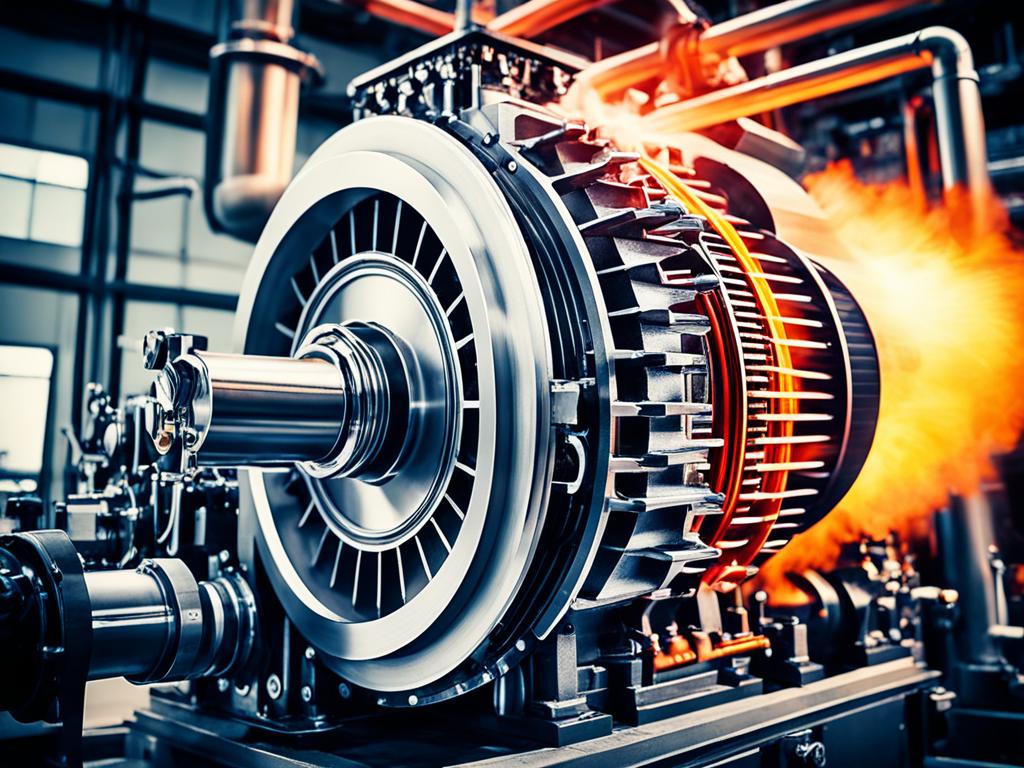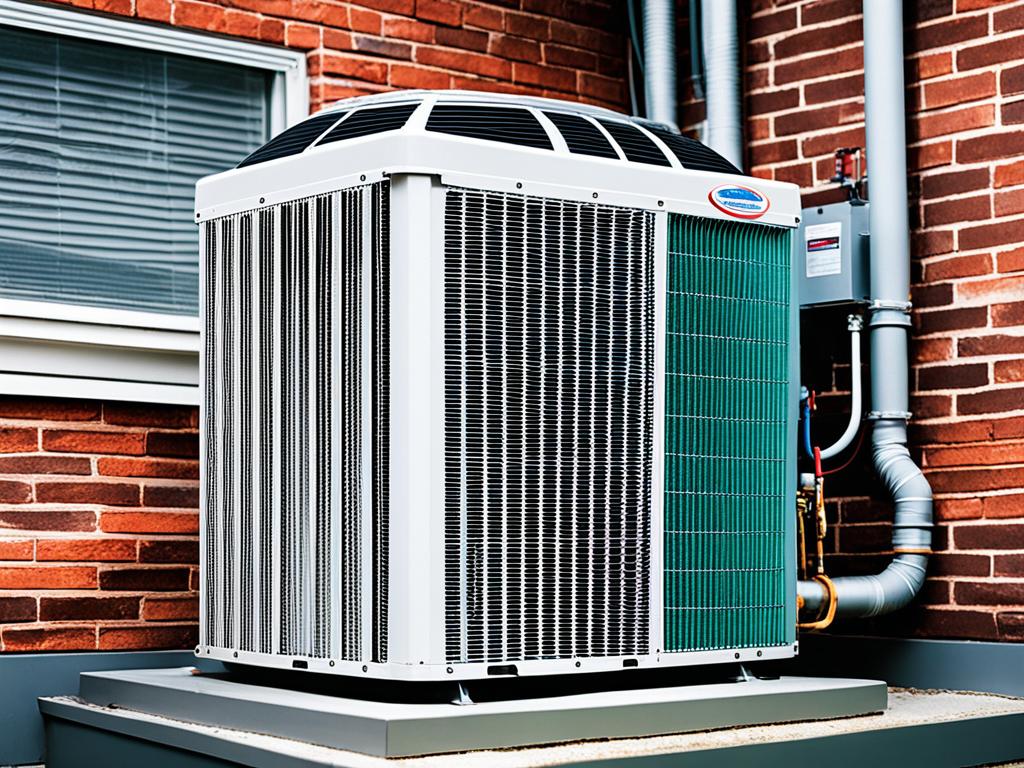The study of thermodynamics impacts many areas. It goes from making power and products to making engines and fridges. All these uses involve changing heat into energy that does work or moving energy well.
Heat engines, heat pumps, and refrigerators are built on thermodynamic principles. They change heat into work or help energy get used better. Heat engines turn heat from something very hot into mechanical work. They also let go of some heat to something cooler. This way, they achieve work, but not all the heat turns useful.
Key Takeaways
- Thermodynamic principles are applied in a wide range of technologies, including engines, refrigerators, and power generation.
- Heat engines convert heat from a high-temperature source into mechanical work, while rejecting some heat to a low-temperature reservoir.
- Heat pumps and refrigerators utilize phase changes and work input to efficiently transfer heat from low to high temperatures.
- The second law of thermodynamics and the concept of entropy play a crucial role in addressing sustainability concerns in thermodynamic systems.
- Thermodynamic principles are essential in transforming heat into useful work and efficiently managing energy transfer in various applications.
Heat Engines: Transforming Heat into Work
Heat engines change heat into work using thermodynamic rules. As fuel burns, it releases energy that becomes heat in a sealed space. This makes the gas inside hot, pushing a piston. When the piston moves, the engine does work, changing heat into useful energy.
Utilizing Thermodynamic Principles to Convert Heat into Work
Heat engines follow the essential laws of thermodynamics. They change part of input heat into moving energy by a series of steps. Machines like car engines, plane engines, and turbines use these principles. They turn burning fuel into power to move.
The work a heat engine does is the difference between the heat it takes in and the heat it gives out. This realizes the second law of thermodynamics. But, these engines can’t be 100% efficient. The laws of thermodynamics and the idea of entropy cause some energy to always be lost.

Heat Pumps: Efficient Energy Transfer
Heat pumps are great at moving energy from one place to another. They can make a space warmer or cooler. When it’s cold outside, they pull heat from the air to make indoors cozy. Heating this way is much more efficient than burning fuel in regular furnaces.
Employing Thermodynamic Principles for Heating and Cooling
The coefficient of performance (COPhp) measures how well a heat pump works. It shows how much heat it can move compared to the energy it needs. A good heat pump can move up to four times more heat than the energy it uses.
Heat pumps work by moving heat from where it’s cold to where it’s warm. They don’t make heat, they just move it. This is why they’re great for heating homes. Fridges and air conditioners work the opposite way, they take heat from inside and send it outside.
| Thermodynamic Principle | Explanation |
|---|---|
| Coefficient of Performance (COPhp) | The ratio of heat output (Qh) to the work input (W) required to operate a heat pump, typically ranging from 2 to 4. |
| Efficiency of Heat Engines | The ratio of work output (W) to heat input (Qh), represented as Eff = W/Qh. This inverse relationship means heat pumps always have COPhp > 1. |
| Temperature Differences | Heat pumps work best when the temperature difference between the hot and cold reservoirs is small, as this maximizes the COPhp. |
Heat pumps are a good choice for many, but they do come with some costs. They use electricity, so in places where electricity is costly, they might not be the best option. They can be more expensive to install than normal furnaces. But in areas with mild winters and low electricity prices, they are a great choice for both heating and cooling.

Refrigeration Cycles and Phase Changes
Refrigeration cycles are key in how we cool and freeze things. They use a refrigerant to move heat. This refrigerant changes from a liquid to gas and back.
The Role of Phase Changes in Cooling and Freezing Applications
A common household fridge has four main parts in its refrigeration cycle: evaporator, compressor, condenser, and expansion valve. The refrigerant changes phase as it moves through these, making the inside colder.
In the evaporator, the refrigerant takes heat from inside, turning into a gas. The compressor makes the gas hotter. It then cools in the condenser, turning back into a liquid. The liquid becomes cold in the expansion valve before returning to the evaporator.
This back-and-forth process removes heat to make things cold. It works in refrigerators, air conditioners, and freezers. They all use this to cool or freeze what’s inside them.
| Stage | Process | Phase Change |
|---|---|---|
| Evaporator | Refrigerant absorbs heat from the inside, causing it to evaporate into a gas | Liquid to gas |
| Compressor | Pressure and temperature of the refrigerant gas are increased | No phase change |
| Condenser | Refrigerant gas releases heat, causing it to condense back into a liquid | Gas to liquid |
| Expansion Valve | Pressure of the liquid refrigerant is reduced, causing it to cool further | No phase change |
Sustainability in Thermodynamic Systems
The principles of thermodynamics, like the second law and entropy, matter a lot in tackling sustainability issues. The second law says entropy, the measure of disorder, always increases or stays the same. This is a key idea for using energy well and cutting down on wasted heat in systems.
Addressing Sustainability Concerns through Entropy and the Second Law of Thermodynamics
The second law makes converting heat into useful work hard because some energy always becomes waste heat. This waste heat is bad for the environment, adding to the carbon footprint and using more energy. By knowing how entropy, energy efficiency, and sustainability are linked, engineers and scientists can make better systems. These systems waste less and use energy better.
To make thermodynamic systems sustainable, focusing on energy efficiency is vital. This involves making better heat engines, pumps, and refrigeration cycles. These systems turn heat into work efficiently or move heat between places effectively. If we lower the entropy in these processes, the systems use less energy and harm the environment less.
Moreover, thermodynamic principles can help in making energy tech greener. This includes things like renewable energy, reusing waste heat, and storing energy. Knowing the rules set by the second law helps researchers and engineers come up with new ways. These ways improve the greenness and efficiency of these energy systems.
To sum up, including thermodynamics in designing systems and technologies is key for sustainability. Using these basics can help us make better, greener, and sustainable systems. This work is critical for a future that is kind to the planet.
The Main Keyword: Applications of Thermodynamics
Thermodynamics is used in many fields, like making power and in our daily equipment. Its main job is to change heat into work we can use or move energy efficiently. For example, car engines go through four key steps to work, either in diesel or gasoline engines.
There are also more advanced ways to use thermodynamics, which do their job well and don’t pollute much. One type is the Stirling cycle, which runs on a loop of squashing and stretching a fluid. Another kind, the Rankine cycle, is in use in steam engines, turning heat into movement with water. Even making use of waste heat is becoming more important, with special materials that stop heat from spreading too much.
Not just power and engines, thermodynamics is in cooling and heating too. Air conditioners use a cycle with a special liquid to take heat away and cool air. Also, heat pumps use thermodynamics to move heat around, either warming or cooling places. Scientists are even looking at how very small heat machines might be much better than what we have now.
Source Links
- https://courses.lumenlearning.com/suny-physics/chapter/15-5-applications-of-thermodynamics-heat-pumps-and-refrigerators/
- https://openstax.org/books/physics/pages/12-4-applications-of-thermodynamics-heat-engines-heat-pumps-and-refrigerators
- https://nerdfighteria.info/v/iZOXW5aaCZg/
- https://www.thepharmajournal.com/archives/2019/vol8issue1/PartM/13-3-11-952.pdf
- https://www.deanfrancispress.com/index.php/te/article/download/305/TE000302.pdf/1347
- https://www.mdpi.com/1099-4300/13/8/1481
- https://www.ncbi.nlm.nih.gov/pmc/articles/PMC9955716/


